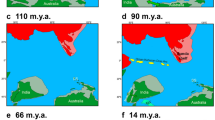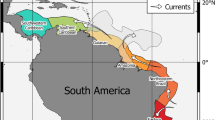Abstract
DURING the Lower Palaeozoic, there was a gradual increase in the similarity of the faunas between North America to the west of the Appalachians, western Newfoundland, northwestern Ireland and Scotland on the one hand, and coastal New England, southern New Brunswick, Nova Scotia, eastern Newfoundland, England and northern Europe on the other hand. The best explanation for this is that the lapetus (or Proto-Atlantic) Ocean was wide enough to separate two faunal provinces in Cambrian times, and that there was progressive migration of the more mobile components of the faunas as the old ocean closed (Fig. 1). The pelagic animals crossed first, followed later by animals (trilo-bites and brachiopods) with pelagic larval stages; but animals without a pelagic larval stage (such as benthic ostracods) were not able to cross until the ocean had closed at one point, though not necessarily everywhere along its length. Finally, faunas limited to fresh water or brackish water (like many Devonian fish) did not cross until there were non-marine connections between the continents on either side of the closing ocean.
This is a preview of subscription content, access via your institution
Access options
Subscribe to this journal
Receive 51 print issues and online access
$199.00 per year
only $3.90 per issue
Buy this article
- Purchase on Springer Link
- Instant access to full article PDF
Prices may be subject to local taxes which are calculated during checkout
Similar content being viewed by others
References
Bergstrom, S. M., and Cooper, R. A., Lethaia, 6, 313–339 (1973).
Neuman, R. B., Proc. 24th int. Geol Congr., Montreal, 7, 297–302 (1972).
Williams, A., in Spec. Pap. Palaeont., 12, 241–269 (1973).
Whittington, H. B., in Atlas of Palaeobiology (edit. by Hallam, A.), 13–18 (Elsevier, Amsterdam, 1973).
Rudwick, M. J. S., Living and Fossil Brachiopods (Hutchinson, London, 1970).
Scheltema, R. S., Biol. Bull., 140, 284–322 (1971).
Thorson, G., in Oceanography (edit. by Sears, M.), Am. Ass. Advan, Sci., 67, 455–474 (1961).
Briden, J. C., Drewry, G. E., and Gilbert Smith, A., J. Geol., 82, 555–574 (1974).
Dewey, J. F., and Kidd, W. S. F., Geology, 2, 543–546 (1974).
Turner, P., and Turner, S., Norsk. geol. Tidds., 54, 183–192 (1974).
Boucot, A. J., et al., Spec. Pap. geol. Soc. Am., 139, (1974).
Author information
Authors and Affiliations
Rights and permissions
About this article
Cite this article
MCKERROW, W., COCKS, L. Progressive faunal migration across the Iapetus Ocean. Nature 263, 304–306 (1976). https://doi.org/10.1038/263304a0
Received:
Accepted:
Issue Date:
DOI: https://doi.org/10.1038/263304a0
This article is cited by
-
The use of biogeography in the terrane assembly of the variscan belt of Europe
Studia Geophysica et Geodaetica (1995)
-
Did Iapetus start to open during the Cambrian?
Nature (1980)
Comments
By submitting a comment you agree to abide by our Terms and Community Guidelines. If you find something abusive or that does not comply with our terms or guidelines please flag it as inappropriate.



